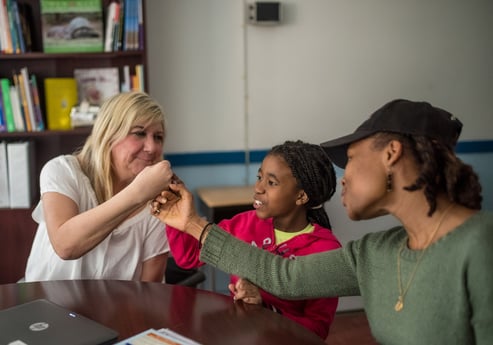TOOLKIT
Build Trust with Your Students and Families

In the Classroom
Build Trust with the Group
Whether you’ve got 20 students or 200, it can be helpful to begin strengthening your relationships with them by building community and learning a little bit about all of your students. In class, you can use icebreakers to help students share who they are, help the students get to know each other more deeply by using morning meetings to spotlight a student of the day, and throughout the year you can have students check in about how they’re doing emotionally with a word or an emoji.
- Strategy: Star Student of the Day [Teaching Channel]
- Strategy: Talk Together: Morning Meeting Protocol [Teentruth.net]
- Strategy: Icebreakers that Rock! [Cult of Pedagogy]
Get to Know Students Personally
The best way to build relationships with students is simply to talk to them, and to listen with focus and curiosity to what they say. Begin the year by giving a student interest survey– this will help you know what kinds of questions to ask students when you talk to them one-on-one. As you learn about your students, keep track of the important interests and people in their lives and refer back to those touchpoints when you’re checking in with them one on one or talking to them outside of class!
- Strategy: How Dialogue Journals Build Teacher-Student Relationships [Cult of Pedagogy]
- Resource: The 360 Spreadsheet [Cult of Pedagogy – use this resource for recording student data]
- Resource: Student Interest Survey
- Sign into a Google account to copy this as a Google Form
- Resource: Trust Generators [Adapted from Zaretta Hammond]
Support Students in Taking Academic Risks
Building on a strong foundation of trust, you can become a “warm demander” by being honest with your students about where they are academically and making a plan for their learning and academic growth with them. You can use 1:1 conferences to set challenging goals with them, break down those goals into achievable steps, and let them know how you will support them along the way.
- Strategy: The Magic of Mistakes: 4 Ways to Boost Critical Thinking with Mistake Analysis [Cult of Pedagogy]
- Resource: Conference Guide for Goal-Setting
- K-2 Resource: My Goal - Draw and Write
- 3-5 Resource: WOOP Template for Goal-Setting [Adapted from WOOP for Classrooms from Character LAB]
Ask for Feedback from Students
Getting the perspectives of our students can help us develop a better understanding of how we show up in the classroom. One way to do this is to ask students for their open and honest feedback about their experiences in our class—not just at the end of the year, but throughout the year.
- Resource: Student Check-in Survey [Adapted from Bright Morning Consulting]
- Sign into a Google account to copy this as a Google Form
Beyond the Classroom
Ask Families about Their Hopes and Dreams
Connecting with families is an essential part of getting to know your students. Start by asking families about their hopes and dreams for their children through a survey or during a conference. In addition to building trust with the family, you will also gain valuable information about their child’s interests, background, prior experiences with school, and home life.
- Learn More: Families’ Hopes and Dreams [Responsive Classroom]
- Resource: Beginning of Year Family Survey -- English | Spanish
Stay Connected to Families
Making time to connect with families, without the agenda of a parent teacher conference, can be an invaluable tool for building trust and mutual understanding. Home visits are especially impactful earlier in the school year to create a strong foundation for the relationship between teacher and family. Setting up a visit at the family’s home is ideal when it’s possible, because it gives families an opportunity to get to know you on their own terms and where they are most comfortable, but connecting with families in other positive ways can also be impactful
- Strategy: Virtual Home Visits [STAND for Children]
- Video: Home Visits With Stanton University [HarvardX]
- Resource: Positive Postcards (English and Spanish) -- Elementary | Secondary
- Resource: Tips for Making a Positive Phone Call Home [PBIS Rewards, "The Power of a Positive Phone Call Home"]
Get to Know the Community
Especially if you are teaching in a neighborhood where you don’t live, getting to know the community is a great way to connect with families. You can do some of your shopping at the local grocery store, visit the local park, or attend school and community events. Alternatively, you can involve community members in your class. Whether you're connecting inside or outside the classroom, you will begin to develop an appreciation for the community and find points of connection.
- Learn More: Spending Time in the Community [Chalkbeat]
- Strategy: 5 Ways to Involve the Community in your Classroom [Resilient Educator]